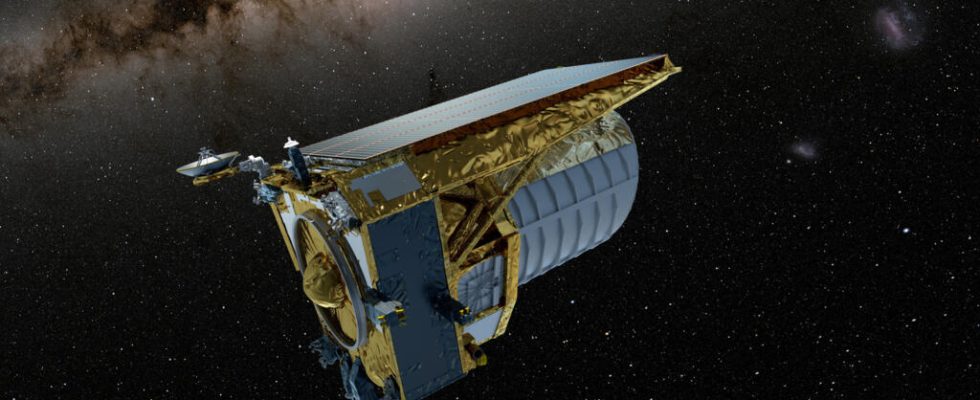It is considered that 95% of the universe is unknown to us. But maybe not for long. The European Space Agency (ESA) is launching the Euclid satellite this Saturday July 1 from Cape Canaveral in Florida. The probe leaves to study the expansion of the universe over the last ten billion years.
A few years after the discovery of the acceleration of the expansion of the universe, the researchers were already talking about the Euclid mission. The source of the acceleration is unknown. They suspect dark energy. Its origin remains a mystery and it is accompanied by dark matter, another component of the universe. In all, it is therefore made up of 95% dark matter and dark energy. Both would be essential to the balance of the cosmos. This ” dark cosmology is a great enigma for physics. Euclid would answer it.
An unprecedented mission
Two tons, 4.7 meters high and 3.5 meters wide. Euclid is designed between the walls of Thalès Alenia Space in Turin, Italy, and Cannes, in the south of France. Its mission is to map the universe, using a telescope one meter in diameter, and understand its evolution over billions of years.
The space telescope will approach James Webb, more than 1.5 million kilometers from Earth. This position, called Lagrange point 2, is the favorite of space agencies. It allows objects, such as probes that reach it, to remain stable. An essential point for Euclid, which requires great precision to produce the largest 3D map of the universe.
A map that will allow scientists to place the galaxies in real time, and to trace their evolution over the last ten billion years. This will measure the accelerating expansion of the universe, which some suspect is caused by dark energy. “ To understand the universe, it is absolutely necessary to finely measure this acceleration in time. “, insists Olivier Joie-La Marle, head of sciences of the universe at the National Center for Space Studies (CNES).
Sort theories
” The current theory, which sticks best to the observations, no longer quite matches because there is an acceleration of the expansion which was not expected. Euclid therefore aims to reduce uncertainties and kill a lot of theories, or even, what we hope, bring out a single family “, hopes Olivier Joie-La Marle.
Since the 2000s, “ maps have been attempted from the ground to advance the domain “. But none have been made in space, and never so precisely. “ It will be a disruption in research, some speak of a Nobel Prize mission “, adds the search for CNES, a smile in his voice.
This sorting will be the result of the work of the Euclid consortium, which has been working on the mission since 2009. More than 2,500 scientists around the world will be able to access the database distributed by the probe, from 2029.
A delayed launch
The European space probe Euclid will launch this Saturday July 1 from Cape Canaveral in Florida. And this despite complications at the end of the mission. In 2022, ESA had to give up its partnership with Russia following the invasion of Ukraine. Euclid was to fly from Guyana, aboard a Russian Soyuz rocket. The war does not allow researchers to continue on this path. The departure can be delayed for more than two years. But given the scientific competition that hovers above the space agencies, the teams quickly turn to a new host. It is SpaceX which propels the Florida probe today.
Initially scheduled for March, the launch is therefore this July 1, barring weather problems. As for the first results, they will emerge within six months. The time that the probe settles down and begins to scan the sky.
